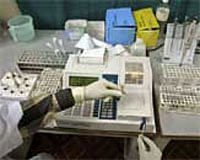Viruses evolve 'sick' ways
Scientists have discovered that viruses regularly evolve new ways of attacking the bacteria that host them in the human body, a finding they say throws insight into one of the mysteries of evolution — where do new traits come from?

In a series of experiments, a team at the Michigan State University found that viruses repeatedly acquired the ability to attack their host bacteria through a different “doorway” or receptor on the bacteria’s cellular membrane.
According to evolutionary theory, natural selection can favour certain members of a population because of traits they possess, such as camouflage or an ability to get at food others can’t reach.
While it’s clear how natural selection causes a population to change, or adapt, explaining how new traits arise has been trickier, said Justin Meyer who led the study.
For their research, the Michigan team studied a virus known as lambda. It is harmless to humans, infecting only the gut bacterium Escherichia coli.
The standard way for lambda to get into a cell is to latch onto its outer membrane, attaching to a particular kind of molecule on the surface of E. coli. It can then inject its genes and proteins into the microbe.
Meyer set up an experiment in which E. coli made almost none of the molecules that the virus grabs onto. But, within 15 days the viruses acquired the ability to infect bacteria through another receptor, the researchers found.
Meyer was surprised not just by how fast the change happened, but that it happened at all. “I thought it would be a wild goose chase,” he said.
In 102 trials, the researchers combined E.coli cells with the virus, called lambda. Lambda normally infects the bacteria by targeting a receptor, LamB, on the bacterium’s outer membrane.
The virus does this using a so-called J protein at the end of its tail; this protein unlocks the door into the bacterial cell, Meyer said.
When cultured under certain conditions, most E.coli cells developed resistance to the virus by no longer producing LamB receptors. To infect the bacterial cells, then, the virus had to find another doorway into the cell.
Once inside, the virus hijacks the bacteria’s cellular machinery to copy its own genetic code and reproduce. In 25 of the 102 trials, the virus acquired the ability to infect bacteria through another receptor.
Deccan Herald is on WhatsApp Channels| Join now for Breaking News & Editor's Picks